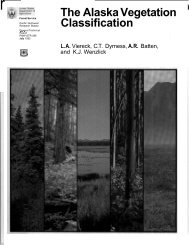Lesson 32 Mineral Cycling - Alaska Geobotany Center
Lesson 32 Mineral Cycling - Alaska Geobotany Center
Lesson 32 Mineral Cycling - Alaska Geobotany Center
You also want an ePaper? Increase the reach of your titles
YUMPU automatically turns print PDFs into web optimized ePapers that Google loves.
• Carbon balance models, despite<br />
their flaws, provide us with the<br />
capacity to interpolate and<br />
extrapolate measurements in time<br />
and space. Hence, they are and<br />
will be a key tool for making<br />
regional and global assessments of<br />
the carbon balance.<br />
• Most data for testing ecosystem,<br />
regional and global carbon models<br />
stems from long term monitoring of<br />
carbon dioxide concentrations and<br />
biomass .<br />
• The Ameriflux network was<br />
established in 1996 to provide<br />
continuous observations of<br />
ecosystem level exchanges of CO 2 ,<br />
water, and energy, spanning diurnal,<br />
synopitc seasonal and intrannual<br />
time scales.Continuous monitoring<br />
of large areas with towers is the<br />
primary method. Chambers are<br />
used for detailed studies of small<br />
patches.<br />
• At present, 40 to 60% of the<br />
anthropogenically-released CO 2<br />
remains in the atmosphere. We do<br />
not know, with confidence, whether<br />
the missing half of emitted CO 2 is<br />
being sequestered in the deep<br />
oceans, in soils or in plant biomass.
















